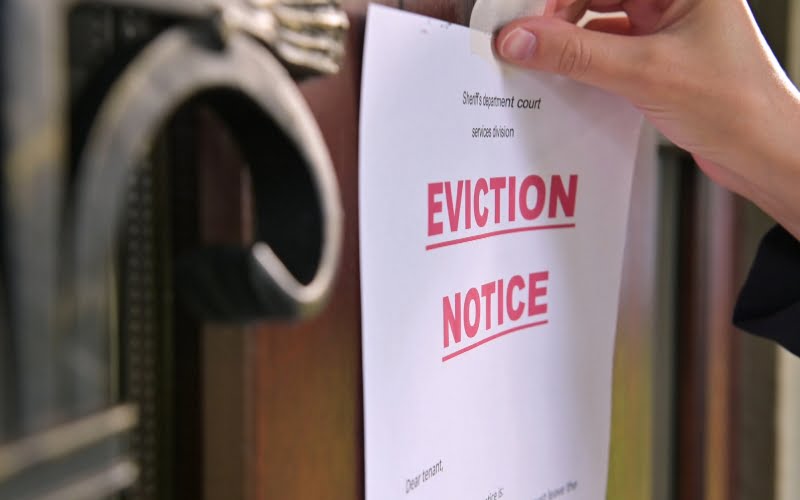
Are you looking to evict a tenant in California with no lease? If so, this blog has you covered! We’ll walk you through the step-by-step eviction process you must take to be successful in removing the tenant from your property.
CA Civil Code 1940-1954.06 grants landlords certain rights. Among these is the right to evict a tenant who has no lease. Aside from that, you may also be able to evict a tenant for other legitimate reasons, such as nonpayment of rent, lease violations, or where you don’t want to renew a month-to-month lease.
To evict the tenant from your California property, you must obtain a court order. You cannot try to remove the tenant in any other way, such as throwing out their personal belongings, locking them out, or shutting down utilities.
These are all forms of ‘self-help’ eviction tactics and are illegal in California as they are elsewhere in the country.
In this blog, we’ll walk you through the step-by-step process you must follow when evicting a tenant in California with no lease.
In California, to evict a tenant without a lease, you must serve them a 30-Day Notice to Vacate.
If the tenancy is less than a year old, you must serve the tenant a 30 calendar days’ notice to vacate. But where the tenancy is 1 year or more, you must serve the tenant with a 60 calendar days’ notice to vacate.
If the tenant doesn’t move out after the expiry of the notice period, you can continue with their eviction by filing an eviction lawsuit in a Superior Court.
If the notice period ends and the tenant is still on the property, you can continue with their eviction by filing an eviction lawsuit against them. In court, you’ll need to file an Unlawful Detainer lawsuit.
Filing an Unlawful Detainer lawsuit in California will set you back by between $240 and $435 in fees.
Unlike an eviction notice, a Summons and Complaint must be served by a process server or the sheriff. You have up to 60 days to have the tenant served after filing the eviction complaint.
Once this is done, the tenant will then have a chance to respond to the allegations. The tenant will have five-ten business days to file the answer. In their defense, the tenant may try to fight their eviction by providing any of the following defenses.
If the tenant fails to respond, you can ask the court for a default judgment without having to attend the hearing. However, if the tenant did respond, then you’ll need to file a hearing request.
Typically, eviction hearings in California are held within 20 days of filing a hearing request. It goes without saying that you should adequately prepare for the hearing by carrying all relevant evidence.
Including, a copy of the lease, eviction notice, summons and complaint, and even witnesses (if any).
If the outcome of the hearing is in your favor, you’ll need to obtain a Writ of Execution.
A Writ of Execution is the tenant’s final notice to leave the property. In California, a Writ of Execution gives a tenant up to 5 days to leave. After which, the sheriff will have to forcibly eject them and return possession back to the landlord.
The tenant may also be able to delay their eviction by filing a stay of execution.
A: Please note that you must serve the eviction notice in a manner prescribed by state law. The following are the options you have.
Make sure to keep the original copy, as well as a declaration of service should you require to adduce evidence in court.
A: Even with no lease, California tenants do enjoy certain rights. The following are some examples.
A: Yes, landlords must have valid legal reasons to evict a tenant in California. You cannot just wake up one day and decide to kick out the tenant from your property for no reason.
Valid reasons to evict a tenant include nonpayment of rent, lease violations, illegal activities, and where you no longer want to renew a month-to-month lease.
A: The amount of time to give a tenant to move out in California will depend on the reason for the eviction. If evicting a tenant for non-payment of rent, for instance, you must give the tenant a notice of at least 3 calendar days.
A: You must follow the exact process in this blog to successfully evict the tenant. You must serve the tenant a 30 days’ advance notice. Then, you may choose to move to court to file an eviction lawsuit (if the matter remains unresolved). You must then obtain a copy of the Summons and Complaint and have the tenant served.
Lastly, you must attend the hearing for the judgment. If the judgment is in your favor, the tenant will have to move out within 5 days, failure to which the sheriff will have to forcibly remove them.
A: Under California law, a lease between a landlord and a tenant can be established in either of three ways. That is, if there is a written or oral agreement, or if payment is accepted as rent.
So, yes, a verbal agreement is legally binding.
A: Here is a comprehensive guide on the topic.
There you have it – a step by step process on how to evict a tenant in California with no lease. Trying other eviction methods such as retaliatory- or discriminatory evictions, as well as ‘self-help’ eviction methods, will all be futile.